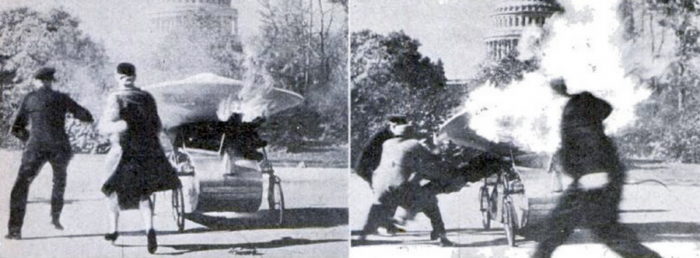 While the Capitol has been the backdrop for, and even the site of, many feats of flying, none have managed to combine hilarity with tragedy quite like the one a number of newsreel cameras managed to catch on October 25, 1935.
While the Capitol has been the backdrop for, and even the site of, many feats of flying, none have managed to combine hilarity with tragedy quite like the one a number of newsreel cameras managed to catch on October 25, 1935.
Crowds had gathered on the lawn of the Library of Congress that day to see a new invention: The Tri-Phibian. The word, an uneasy conglomeration of “tri” and “amphibian,” had been invented by Constantinos H. Vlachos (pictured) and Edward L. Rice. The vehicle so named was to be equally at home in the air, on land and on water. Rice had been at work on this marvel since 1906, while Vlachos had joined him a few years earlier.
Had the crowd been more aware of the inventors’s history, the expectations would have been much lower. Just a few years earlier, Vlachos had been arrested in Lynchburg Virginia, on the charge of “fraudulent misrepresentation.” He had sold a share of the grandly named “Rice Manufacturing & Aerial Transport Co.” to a local worthy, a share of company that was entirely unknown to the D.C. police, in spite of Vlachos’s claim that it was based there.
Whatever punishment Vlachos brought down on himself was behind him by 1935, and he was generally believed when he insisted that this new invention had been tested on land and in the air, and that it had reached an altitude of 70 feet. This in spite of its odd appearance, which the Washington Post described thusly:
The machine looks like a motorcycle side car on four wheels. Above it is a cylinder-shaped hood, constructed of a special fabric.
Vlachos climbed into his invention, the newsreel photographers began filming. The Post described the next moments:
Everything was going smoothly. The contraption was in motion, Vlachos was smiling, the newsreel men were cranking – then, poof! the machine burst into flames.
The inventor was trapped in the “cockpit.” Huddled in the bathtub-sized metal body, he couldn’t move. Nearby stood Policeman J. E. Baker, of the Ninth Precinct, fresh from police school. He dashed to the rescue, braved spurting tongues of fire and dragged Vlachos to safety.

Two frames of the newsreel shot on that day., taken from Popular Science of January , 1936 (Google Books)
Vlachos was interviewed from his hospital bed. He insisted that “he would ‘try again’ as soon as he was able.” However, given that he also insisted that his plane would be sold for $50 each, and that he and Rice were planning on building 25,000,000 of them, his capacity for rational thought may have been diminished at that moment, especially as his wife had admitted to the Evening Star that the Tri-Phibian had not, in fact, ever managed to get off the ground.
Vlachos would continue to get in trouble with the law in trying to raise money for his invention, and would eventually move to Washington State, where he turned to inventing a new type of car, the Phibian, which made no effort to fly through the air or sail through water. Its engine was unusual, using a fluorocarbon heating and cooling cycle to drive the wheels, rather than gas explosions. Vlachos managed to patent this invention, but never raised the money to turn it into reality, a situation he blamed on the oil companies. The inventor continued to work until his death in 1987, though none of his inventions brought him the fame that he felt he deserved, or the ignominy and pain he had suffered in sight of the Capitol in 1935.
